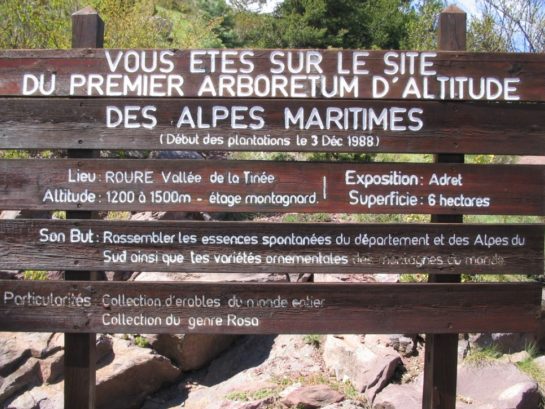About
The site
Location : Alpes-Maritimes, Tinée Valley, Municipality of Roure
GPS coordinates : 44°6’ North latitude – 7°5’ East longitude
Area : 17 hectares
Exposure On the adret (sunny side).
The Arboretum is bordered by the GR5 (European Long Distance Trail starting from Holland and arriving in France, in Nice).
Climate : A veritable biogeographic crossroads, the opening towards the sea offers a microclimate allowing the introduction and evolution of southern species
Altitude : 1200 to 1722 m (mountain level).
Geology Wine-coloured pelites dating from the Permian (260 million years).
The "purple" colour of these pelites comes from its high content of iron oxide.
Soil : Acidity PH 5.70


The medieval
village of Roure
Around 1067, called “Rora” (which means oak), Roure, having belonged to the Grimaldi, is an "all purple" village from the earth to the slate roofs of the houses. The latter stretch out like a circus facing the Tinée valley and reveal a Baroque church. A little higher up there is a small chapel housing the so-called "sin of flesh" fresco, painted by Andréa de Cella in 1510. A curious machinery in the heart of the village linked Roure to St Sauveur, it evokes a compression of Arman or "the Modern Times" by Charlie Chaplin.
Ecological data
The Alpes-Maritimes: the only region in Europe to have all levels of vegetation from the most Mediterranean to the most alpine. Remember that the Alpes-Maritimes extend from the shores of the Mediterranean to the peaks of the Argentera-Mercantour Massif which exceeds 3000 meters in altitude. Hence the richness of its vegetation which changes according to various ecological factors.

Étage thermoméditerranéen (0 à 200 m environ) : localisé sur le littoral mais fragmentaire ici : avec le Caroubier, l’Olivier sauvage ou Oléastre, le Palmier nain, le Myrte, le Lentisque, l’Euphorbe arborescente, le Pin d’Alep, le Chêne vert.
Étage mésoméditerranéen (0 ou 200 jusqu’à 600 m environ) : avec le Chêne vert, le Chêne pubescent, le Pin d’Alep, le Pin mésogéen ou Pin maritime, le Pin parasol, le Chêne liège, le Genévrier de Phénicie, le Genévrier oxycèdre ou Cade, le Romarin, le Thym vulgaire, la Lavande à larges feuilles ou Grande Lavande ou Aspic, le Lentisque, le Myrte, le Calicotome épineux, le Filaria à feuilles étroites, le Genêt d’Espagne ou Spartium à tiges de Jonc.
Étage supraméditerranéen = étage collinéen de type subméditerranéen (600 à 1100-1200 m environ) : avec le Chêne pubescent, l’Ostrya à feuilles de Charme ou Charme-houblon, le Frêne à fleurs ou Orne, le Chêne chevelu, le Pin sylvestre, le Châtaignier, le Genévrier commun, le Genêt cendré, le Buis, la Lavande officinale ou Lavande vraie. N.B. À côté de cet étage collinéen de type subméditerranéen qui occupe une très large part de cet espace altitudinal surmontant l’étage mésoméditerranéen, il existe encore dans les Alpes Maritimes un étage collinéen de type médioeuropéen.
Étage collinéen de type médioeuropéen : avec le Chêne sessile, le Bouleau blanc, le Charme, le Noisetier ou Coudrier.
Étage montagnard (1100-1200 à 1600-1700 m environ) : avec le Sapin blanc, le Hêtre, l’Épicéa élevé, le Pin sylvestre, le Noisetier ou Coudrier, le Pin à crochets, le Mélèze d’Europe (ces deux derniers étant surtout subalpins), des Genévriers : Genévrier commun, Genévrier thurifère, Genévrier Sabine, le Cytise hérissé.
Étage subalpin (1600-1700 à 2300-2400 m environ) : avec le Mélèze d’Europe, le Pin cembro ou Arole, le Pin à crochets, le Pin mugho ou Pin nain, l’Épicéa élevé, le Rhododendron ferrugineux, le Genévrier nain, les Airelles : Airelle des marais, Airelle myrtille, le Raisin d’ours ou Busserole.
Étage alpin (2300-2400 à 3000 m environ) : avec en particulier les pelouses alpines qui s’étendent au-dessus de la limite supérieure de la végétation arborescente. Il faut souligner que les activités anthropozoogènes (actions de l’Homme et des animaux domestiques) ont abaissé considérablement la limite supérieure potentielle de la forêt et, donc, que beaucoup de pelouses de haute altitude ont ainsi une origine anthropique.
Étage nival (au-dessus de 3000 m environ) : avec une végétation qui, en raison de l’augmentation de l’altitude et du manque de sol, devient de plus en plus clairsemée, de plus en plus pauvre en plantes vasculaires mais qui, grâce aux seuls lichens, peut cependant atteindre les plus hauts sommets.
Extrait simplifié tiré de la brochure disponible à l’Arboretum et intitulée : « À la découverte de l’Arboretum d’altitude Marcel Kroenlein de Roure » (Alpes du Sud – France), Par Henri SANDOZ, Président du Comité Scientifique de l’Arboretum d’altitude Marcel Kroenlein de Roure (Deuxième édition, 2014).
Missions
Raising awareness of the preservation of the environment and the protection of the high altitude tree heritage of the Alpes-Maritimes.
Gardening training.
A better geographical knowledge of the
Alpes-maritimes
Teaching artistic expression.
A solidarity action, integration through the transmission du savoir, intended for people in social and professional difficulty.
The history of the Arboretum
1987 : Mrs Michèle Ramin, future president, meets Marcel Kroenlein, at the time, director of the Exotic Garden of Monaco. She tells him of her desire to highlight the natural wealth of the region. The great botanist then suggested that he create an arboretum !
1988 : The adventure begins, managed by an association law 1901 and the first trees are planted on an original alpine lawn.
1989 : Renowned artists such as Arman, Cesar, Folon, Jean Marais and Ousmane Sow strongly supported the Arboretum in their time. They will be followed by many others including Slobodan, Ernest Pignon Ernest, Valerio Adami, Nicolas Lavarenne...
1998 : Creation of a scientific committee chaired by Dr Henri Sandoz
2001 : Creation and installation of a landscape reading table
2002 : Opening of the Bookstore and Library of the Arboretum
2003 : Meeting with Denis Gibelin President of the “no-made”First “no-made” exhibition
2005 : Creation of the ornithological trail trail from birds identified on the site and sculpted life-size by Mr. Belaud.
2008 : Creation of the Study Incubator.
2010 : Obtaining the Label « remarkable garden », the Arboretum is registered in the national heritage of the Ministry of Culture.
2012 : Obtaining 10 additional hectares to reach the mountain level 1722 m.
2013 : Obtaining the Handi Tourism Label
2018 : 30 years since the first tree was planted. 30 years of presidency of Michèle Ramin, co-founder who hands over to Jean Mus, the new elected President, the Marcel Kroenlein arboretum.
2018 : Obtaining the Tourism Quality Label
2019 : The 30th anniversary of the association law 1901
